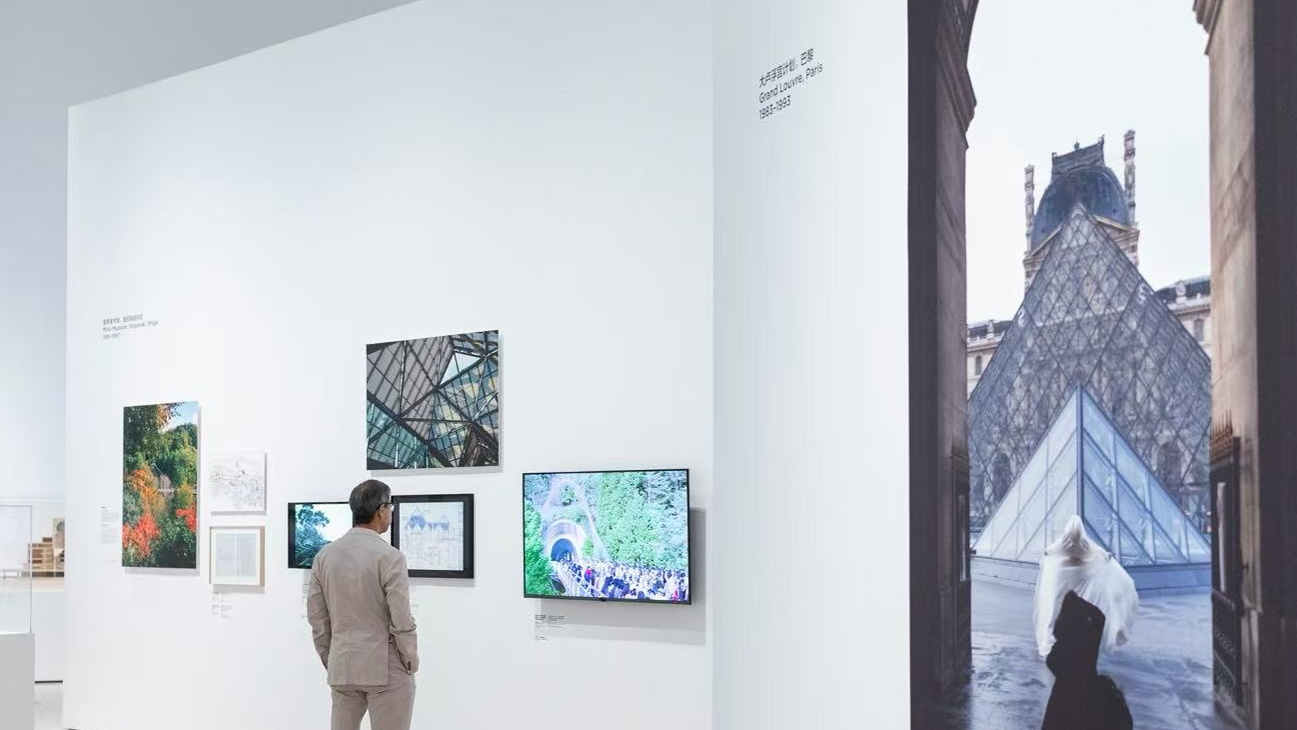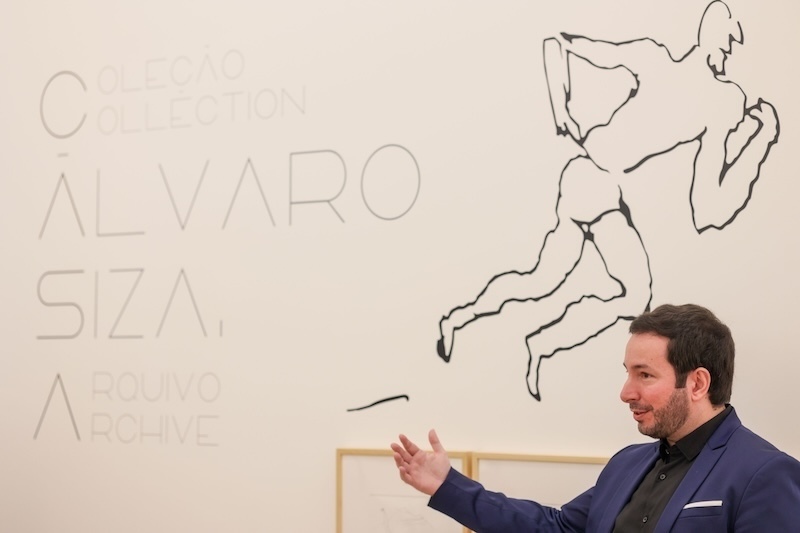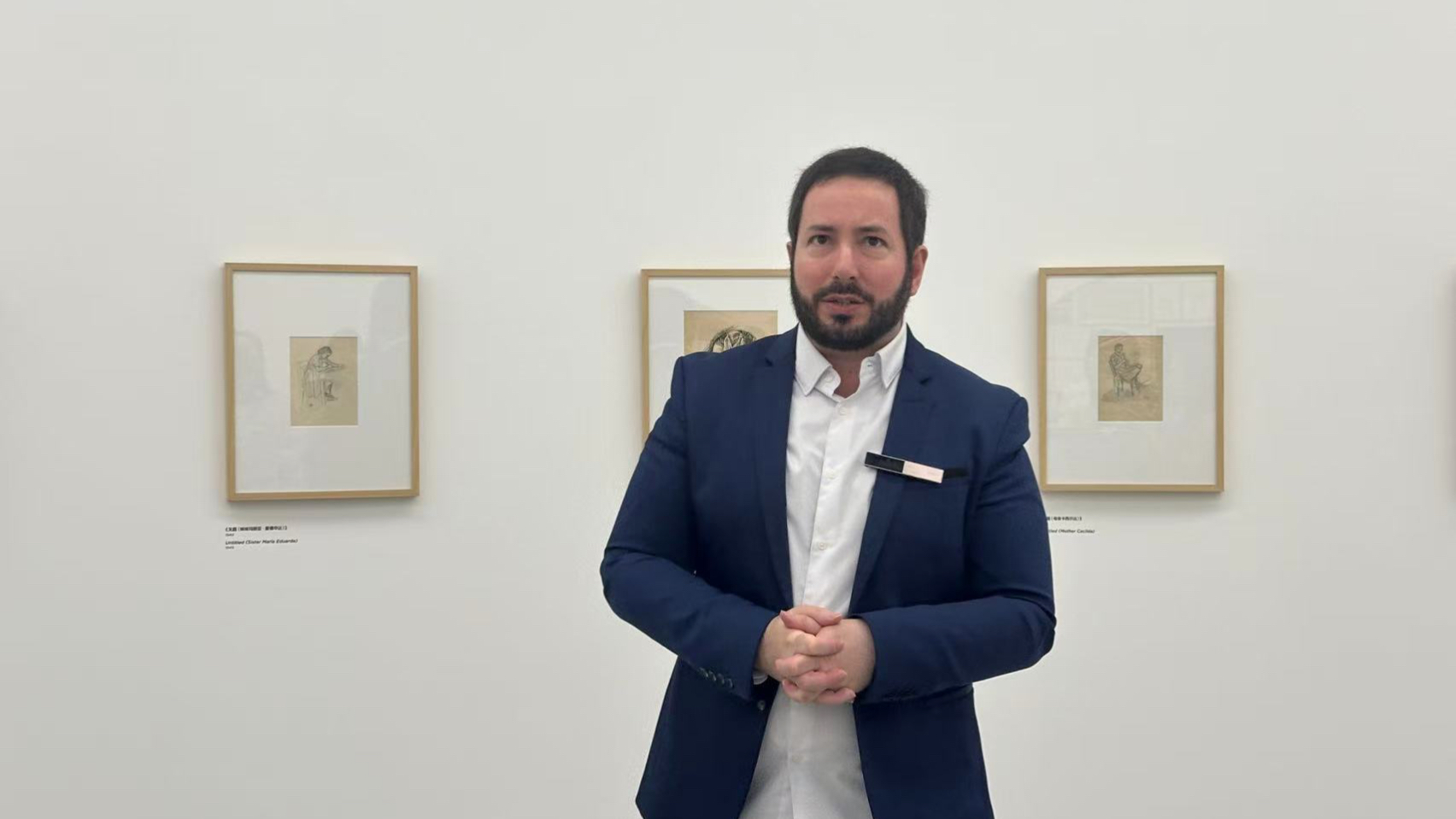
"I.M. Pei: Life as Architecture" is currently on display at the Power Station of Art (PSA) in Shanghai. On June 19, Pei's son and current chairman of Pei Partners Architecture, Li-chung Pei, visited the Shanghai exhibition hall.
"Shanghai is the 'starting point' of my father's dream and the source of his interest in multiculturalism. Shanghai played a huge role in the formation of his temperament. Shanghai is of vital importance to my father - and it also means a lot to our entire family," said Bei Lizhong in an exclusive interview with The Paper Art Review.

I.M. Pei and his wife had three sons and one daughter. Sandi Pei is the third son. His English name is Sandi, which is pronounced as "Sandi" in Chinese. Although Sandi Pei's Chinese is unfamiliar, when he appears in front of us, his words and expressions still carry the temperament of traditional Chinese culture, and he is neither hurried nor slow, gentle and amiable.

Pei Lizhong at the “I.M. Pei: Life as Architecture” exhibition at the Power Station of Art (exhibition extended to August 10)
Lizhong Pei holds a Bachelor of Arts degree from Harvard University and a Master of Architecture degree from Harvard Graduate School of Design. Over the past four decades, he has been involved in more than fifty projects around the world, including educational facilities, laboratories and museums, as well as commercial office buildings, hotels and residential projects. Among the projects that Lizhong Pei created with his father, he played a leading role in the MIT Arts and Media Technology Facility (Media Lab) in Cambridge, Massachusetts, the headquarters of the Creative Artists Agency in Beverly Hills, California, and the Bank of China Building in Hong Kong.
This time he came to the Shanghai Museum of Power Station of Art to attend the public lecture " More Than Just a Dialogue in Form - Xu Bing and Pei Lizhong Talk about I.M. Pei, Art and Architecture " co-organized by M+ and PSA. During the lecture, he had a dialogue with artist Xu Bing, shared architectural practices, and explored the relationship between art and architecture.

Scene of the public lecture "A Dialogue Beyond Form: Xu Bing and Pei Lizhong Talk about I.M. Pei, Art and Architecture". From left to right: Pei Lizhong, Wang Lei (curator of the "I.M. Pei: Life as Architecture" exhibition and M+ Design and Architecture), Xu Bing.
In an exclusive interview with The Paper | Art Review, Bei Lizhong mentioned his mother and the family time he spent with his parents. But when it comes to the issues of architecture and art, nature and society, Bei Lizhong, as an architect with a global vision, gave his responses carefully and firmly.

Bei Lizhong walks into the exhibition hall
Talking about parents: I hope there will be books about my mother
In Bai Lizhong's memory of his youth, his father was often away on business trips and he was in boarding school, so they didn't spend much time together. "He was a great father, gentle and wise. He was not the kind of father who was strict or often disciplined his children, but he led by example and taught by words and deeds. Through his way of dealing with people, his attitude towards work, and the admiration he received, I wanted to emulate him and become that kind of person."

Ieoh Ming Pei (right) with Pei Lizhong (center) and Pei Jianzhong
In addition to his father, Pei Lizhong also talked about his mother, Lu Shuhua. After Pei Ming passed away, she was often forgotten in the narrative, but Lu Shuhua made an indelible contribution to Pei Ming's success.
Lu Shuhua studied at Wellesley College and received a senior scholarship. It was also under her influence that I.M. Pei chose to study for a master's degree in architecture at Harvard. They studied together, shared their passion for art, and eventually got married and spent their lives together. "My father admired her judgment very much. More importantly, she was always there when support was needed. My mother took care of us children alone, allowing my father to devote himself to his architectural work." Pei Lizhong said, "No matter how much people write about my father, I will be happy as long as someone is willing to write about her - because she is extremely important to my father's success."

I.M. Pei and his wife Lu Shuhua in Hong Kong, 1988
Lu Shuhua maintains the rhythm of the family. "She always arranges for us to have dinner together and reunite on weekends." Bei Lizhong is amazed by his mother's cooking skills. "She is a master of French cuisine. They traveled to Europe and visited the best restaurants. After tasting them, she returned to New York and her cooking skills became better than before. Cooking is a kind of enjoyment and fun for her."
"My father has a mature taste aesthetic. He likes French and Italian food, and he can't forget Shanghai braised pork. He likes to drink a martini or whiskey before dinner, and he also loves wine." This seems to reflect I.M. Pei's consistent pursuit of life and art. "But my father can also eat very simply sometimes. A plate of spaghetti with tomato sauce will also make him very satisfied." Bei Lizhong recalled.

I.M. Pei and his family vacation in Europe
Compared to watching movies, the Pei family often goes to art galleries and travels. "We used to have artist friends visiting our house. My mother also knows a lot about art. She knows many artists and has close relationships with many of them." This family atmosphere of symbiosis with art has profoundly influenced Pei Lizhong. He admits that his love for art comes from his family, and he still maintains a close connection with the art world. He and his artist friends also have a "common language" - a relationship of mutual understanding, which he also learned from I.M. Pei.
Talking about architecture: Architecture must respond to the present and be responsible for the future
As an architect, his father, I.M. Pei, had a profound influence on Pei Lizhong, but this influence was subtle. Pei Lizhong admitted that his background of receiving education, working and practicing in the West, and those seemingly "distant" memories of China, slowly shaped his own view of architecture.

I.M. Pei on a bridge at the Lion Grove Garden in Suzhou, circa 1930s. Courtesy of Peikoff & Partners.
"My father's life in China, especially his experiences in Suzhou and Shanghai during his youth, gave him a sensitivity and understanding of 'gardens', the relationship between architecture, nature and art," Bei Lizhong recalled. For example, Suzhou Lion Grove is a walled Jiangnan garden with its own world inside. "In such a garden, my father came into contact with strange stones - those Taihu stones that were placed and arranged by early family members (perhaps dating back fifteen or sixteen generations, or even the Ming Dynasty). These stones were quietly deposited and washed along the water's edge, slowly eroded and shaped. This long-term change means that each generation sees slightly different stones, but they maintain continuity with each other."

Ieoh Ming Pei in Suzhou
As I.M. Pei often said, "Those who plant trees will enjoy the shade." He realized a philosophical thought from this: as an architect, his task is not to build eternity, but to grasp the "present" where he is, and to build in a way that is connected to the past and can be continued by the future. "Even though I am in the West and mostly engaged in Western architectural projects, I have always maintained such a sense of responsibility: architecture must respond to the present and must be responsible for the future - architecture must be done with cultural awareness, historical awareness, respect, and the appropriateness of solving current problems."

The lobby of Suzhou Museum (2000–2006) frames the main landscape, including the stone landscape in the garden, Suzhou, 2021. Photo: Tian Fangfang. Commissioned by M+
In Bei Lizhong's view, China's development since the 1980s and 1990s can be described as "leapfrogging". In terms of infrastructure construction, urban function integration and even the application of architectural technology, China has not only caught up, but has even "directly surpassed the West" in many aspects.
"But sometimes, urban design needs to 'slow down' and think more restrainedly and farsightedly about 'why' it is built." Bei Lizhong said, "I am proud of China's current achievements, but I am also concerned about the future development direction.

Bei Lizhong being interviewed. Photo by Huang Song, a reporter from The Paper
Dialogue|Bei Lizhong: Shanghai is very important to my father and has extraordinary significance to the entire family
The Paper: You tend to view art as a collaborative element in the architectural process. What do you think is the relationship between architecture and art?
Bei Lizhong: Yes, I do think that art should be a part of the close collaboration with architecture, rather than being treated as a decoration that is “hanged” after the building is completed, or an “add-on” to the building. Although my father and I have different ways of collaborating—I work with artists of different scales, and he also works with artists—we both firmly believe that “collaboration” is the key.
I think the essence of collaboration is that artworks should resonate with the architectural environment, and even evoke an atmosphere similar to the co-creation of art and space during the "Renaissance" period.

In the exhibition, I.M. Pei’s architecture and artists’ works are sorted out.
My father particularly liked abstract art because he thought figurative art was incompatible with architecture in terms of scale. I remember that he went to Florence and saw Michelangelo's David. He realized that a highly realistic sculpture would be abrupt, unbalanced, and out of proportion if it was enlarged to 30 feet high. Abstract art can communicate more freely with buildings of different scales. This is why his later artistic collaborations tended to be with abstract artists.
The Paper: The Hong Kong Bank of China Tower is a collaboration between you and your father. Which aspect of your father's architectural philosophy do you think this project best reflects? What is its significance to your personal architectural career?
Bei Lizhong: The core idea of this building was proposed by my father. He conceived a diagonal bracing structure to reduce the amount of steel used and enhance the ability to withstand typhoons and other wind forces. This structure is both efficient and economical, and can be regarded as a major technological innovation.
My contribution was mainly in the engineering part, especially in the cooperation with the structural engineers to further promote this concept. In addition, I also participated in the design of the building base and landscape garden, and made some optimizations in the high-rise space, but the most important thing about this building is its structural innovation.

Bank of China Building (1982–1989), Hong Kong 2021: Photographed on commission by M+ © Ho Siu Nam
This is one of the most important projects in my career. This project started in 1982, more than 40 years ago. At the time, it was a very bold and efficient solution. And it is not "the end of an idea", we continued to explore similar structural systems in other buildings. For example, a project I completed in Indonesia and the Dishui Lake International Trade Center (tentative) we are currently building in Shanghai are trying to respond to some of the shortcomings of the Bank of China Tower in Hong Kong in terms of details by using larger windows, better floor heights, and improved lighting.
What I want to say is: The Bank of China Tower in Hong Kong puts forward the concept of "economically building high-rise buildings", and our current job is to keep this concept evolving.

Dishui Lake International Trade Center (tentative)·Aerial view © Pei Architects
The Paper: As you mentioned, the Dishui Lake International Trade Center (tentative) under construction in Dishui Lake, Shanghai, is seen as a continuation of the Bank of China Tower in Hong Kong. How does it reflect the combination of Pei’s traditional and contemporary architectural language?
Pei Lizhong: This is exactly what we wanted to achieve in this project. As I just mentioned. We made the windows bigger - both in width and height. The windows of Hong Kong Bank of China were only about 1.3 meters square, and now we use a more modern and energy-efficient glass system, which greatly improves the sense of openness and comfort of the space. The ceiling height is also higher, and the overall energy efficiency is better.
Times have changed, and we can now use new technology to continue a classic design language. This building has almost become one of our firm’s “signature” works.

The Dishui Lake International Trade Center (tentative) under construction, photographed on June 12, 2025
The Paper: I.M. Pei spent his youth in Shanghai. What are your feelings towards Shanghai?
Bei Lizhong: My father spent a very critical period of his growth in Shanghai, which played a decisive role in his later development as an architect.
He was born in Guangzhou, but moved to Shanghai when he was about ten years old, where he lived for nearly ten years until he went to the United States to study at the age of 17. This period of time had a profound impact on his world view, outlook on life, and even aesthetics.

Shanghai International Hotel
He attended the YMCA Middle School in Shanghai, where he was exposed to many Western ideas. Shanghai was a very international city at the time, and he fell in love with movies, especially Hollywood movies. He saw American campus life, jazz music, beautiful girls in the movies... He was deeply attracted by all of this and decided to go to the United States.

The gate of Shanghai YMCA Middle School (now Tongji Huangpu Design and Creative Middle School), where Ieoh Ming Pei once studied, has been basically restored to its original appearance
So I think Shanghai is a "starting point of a dream" for him, and also the source of his interest in multiculturalism. And this interest (respect and learning of the culture, customs and traditions of different regions) also contributed to his later architectural projects in France, Germany, Qatar, Japan and China.
He was a true intellectual, a polymath, and I firmly believe that Shanghai played a huge role in shaping him. Therefore, Shanghai is very important to my father - and to our entire family.

The Pei family took a group photo in the garden of Pei Zuyi's residence (owned by the Bank of China) on Fuxing Road (now Wukang Road) in Shanghai. Back row: I.M. Pei (third from left), Pei Zuyi (sixth from left), sitting: I.M. Pei's grandfather, Litai Pei (fifth from left), 1935. © Copyright, provided by Pei Qia


